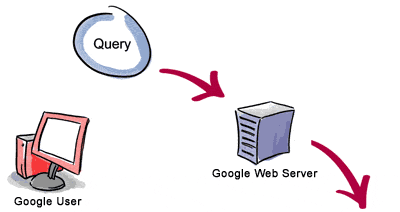Google stands alone in its focus on developing the "perfect search engine," defined by co-founder Larry Page as something that, "understands exactly what you mean and gives you back exactly what you want." To that end, Google has persistently pursued innovation and refused to accept the limitations of existing models. As a result, Google developed its own serving infrastructure and breakthrough PageRank™ technology that changed the way searches are conducted.
From the beginning, Google's developers recognized that providing the fastest, most accurate results required a new kind of server setup. Whereas most search engines ran off a handful of large servers that often slowed under peak loads, Google employed linked PCs to quickly find each query's answer. The innovation paid off in faster response times, greater scalability and lower costs. It's an idea that others have since copied, while Google has continued to refine its back-end technology to make it even more efficient.
The software behind Google's search technology conducts a series of simultaneous calculations requiring only a fraction of a second. Traditional search engines rely heavily on how often a word appears on a web page. Google uses numerous factors including its patented PageRank™ algorithm to examine the entire link structure of the web and determine which pages are most important. It then conducts hypertext-matching analysis to determine which pages are relevant to the specific search being conducted. By combining overall importance and query-specific relevance, Google is able to put the most relevant and reliable results first.
- PageRank Technology: PageRank reflects Google's view of the importance of web pages by considering more than 500 million variables and 2 billion terms. Pages that Google believes are important pages receive a higher PageRank and are more likely to appear at the top of the search results.
PageRank also considers the importance of each page that casts a vote, as votes from some pages are considered to have greater value, thus giving the linked page greater value. Important pages receive a higher PageRank and appear at the top of the search results. Google's technology uses the collective intelligence of the web to determine a page's importance. There is no human involvement or manipulation of results, which is why users have come to trust Google as a source of objective information untainted by paid placement. - Hypertext-Matching Analysis: Google's search engine also analyzes page content. However, instead of simply scanning for page-based text (which can be manipulated by site publishers through meta-tags), Google's technology analyzes the full content of a page and factors in fonts, subdivisions and the precise location of each word. Google also analyzes the content of neighboring web pages to ensure the results returned are the most relevant to a user's query.
Google's innovations don't stop at the desktop. To bring its accurate and speedy search results to users accessing the web through portable devices, Google also pioneered the first wireless search technology for on-the-fly translation of HTML to formats optimized for WAP, i-mode, J-SKY, and EZWeb. Currently, Google provides its wireless technology to numerous market leaders, including AT&T Wireless, Sprint PCS, Nextel, Palm, Handspring, and Vodafone, among others.
Life of a Google Query
The life span of a Google query normally lasts less than half a second, yet involves a number of different steps that must be completed before results can be delivered to a person seeking information.
 | |||
| 3. The search results are returned to the user in a fraction of a second. | 1. The web server sends the query to the index servers. The content inside the index servers is similar to the index in the back of a book - it tells which pages contain the words that match the query. | ||
 | 2. The query travels to the doc servers, which actually retrieve the stored documents. Snippets are generated to describe each search result. |  |
 | ||

No comments:
Post a Comment